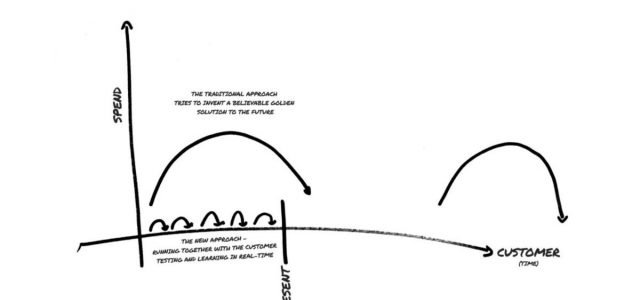Forbes magazine and Price Waterhouse Coopers just completed a study on ‘Leading With Customer-Focused Content,’ which on the surface can sound a bit buzzword-heavy. Essentially, it’s about a two-pronged idea:
- Content is important
- Personalized content — in essence, stuff a consumer actually would want/care about — is very important
We have a couple of factors that are hurting marketing departments and companies in terms of effectively creating content or, even better, personalized content. To wit:
The challenges of content and personalized content
- Average CMO tenure isn’t that long, so there’s turnover in terms of marketing department ‘visions’
- Business models are shifting — ‘brand’ used to be the thing, and now it’s much more about customer relationships
- Most CMOs are older and don’t completely understand digitally-driven business models
- Oftentimes, marketing departments don’t completely understand what ‘content’ means — they confuse it with ‘sales’ or ‘marketing copy’
To remedy these problems or concerns, most marketing departments do something along these lines:
- Hire a consultant (not always ideal)
- Buy a program or suite of products to automate/scale (not always ideal)
- Cling breathlessly to the metrics they already understand and throw those up the chain at every turn (not always ideal)
- Claim that ‘content marketing’ is a fad and won’t be tied to sales (not always ideal)
The bottom line here is fairly simple: marketing, as a field, needs to evolve to meet potential customers/consumers/advocates/whatever you want to call them wherever they are.
Consider this, for example. At the job I just had, we used Kentico as a CMS (content management system). Based on this video, they clearly have some personalized content options.
We never used a single one. It basically never came up. That’s life sometimes.
So, now we know what the problems are. Are there solutions?
How can marketing departments get better at content and personalized content?
- Start by thinking about your ‘end users,’ or customers. This doesn’t have to be done in an official persona way, but it can be. When you think about them, here’s what you need to think about:
- Who are they?
- Where are they?
- What types of companies/professions?
- Where do they spend time online?
- What are your competitors doing to reach them? (Don’t necessarily do the same thing)
- What problems/pain points do you see them having?
- How can you fix those problems?
- What stories do you think would resonate with them?
- How busy are they? How busy do they think they are?
- Are they evolved enough that they can figure out when something is just an ad?
That’s a starter list. If you have a generally-good idea of who your targets are, why they are your targets, and where to find them … then you can move on to the how of getting it done. That’s essentially what a “marketing campaign” is, although we confuse that term a lot because we’re always breathlessly screaming about “re-brands!” and the like.
2. Now we’re at the how, or the execution phase. Here are the things marketing departments sometimes screech about and think it’s meaningful without a plan:
- Data-driven marketing!
- Personalized content!
- Customer experience!
- Omnichannel strategy!
All those things are awesome and great, but they mean absolutely nothing if you haven’t put any thought into it. For most marketers, “data-driven marketing” basically means (a) hire a consultant, (b) pay HubSpot some money, and (c) blog a little bit, send some e-mails, and do Facebook ad buys. That’s not what data-driven marketing really is or should be, but we often confuse terms in other terms at work.
Here’s the type of stuff you need to think about with content:
- What types will they like? (Dirty little secret: no one really likes ‘white papers’ as much as consultants claim we all do)
- How do they want to be reached/contacted?
- What social networks are they on?
- What are your end goals? (An e-mail address? A conversation? A sale?)
I would tackle those four areas before we even attempt to approach ‘personalization,’ which is a whole big thing on top of what we’ve already discussed. Most marketing departments think ‘personalization’ is “Adding the person’s first name to a sales e-mail,” which it’s not either. It’s sending something that the person will actually care about and/or showing that you value them as anything other than cash with fingers. Most companies are not great at valuing consumers, though.
Content as the alignment of strategy and execution
Tons of people in marketing that I’ve worked with or done freelance for will say something like this:
“We’re producing content, but it’s just going into a void! It’s not working! No clicks!”
I hear all that. It’s probably true, too. Here’s the thing, however:
- You don’t get paid in likes and clicks; that’s not what you should be tracking
- (You don’t get paid in impressions either)
- People ignore content when it’s boring, not relevant to them, the same old crap everyone else is doing, or …
- If they can’t find it or it doesn’t get in front of them
If you look at the last two bullets, what you need to do is figure out:
- How to write different, interesting, value-add stuff (or create/produce it)
- How to get it in front of people
That’s essentially the alignment of strategy and execution. You know what else happens at that alignment? All of successful business.
That’s all ‘content’ is, then: it’s a microcosm of the way your entire business ecosystem has to work. If you can make other things work, you can make ‘content’ work too. But it has to have a strategy (why and who) and an execution (where and how). It’s that simple.
My name’s Ted Bauer; I blog here regularly and you can learn about hiring me for freelance and contract gigs as well. You can also subscribe to my newsletter.
Article by channel:
Everything you need to know about Digital Transformation
The best articles, news and events direct to your inbox
Read more articles tagged: Content Marketing, Featured






